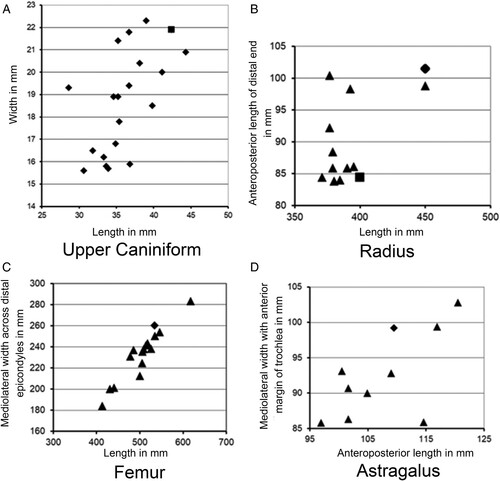Figures & data
FIGURE 1. Megalonyx jeffersonii localities in North America and Iowa. Iowa map includes county borders. Star, Tarkio Locality. Circles, Wisconsinan localities. Triangles, Sangamon localities. Black, localities recorded in Hoganson and McDonald (Citation2007). Red, localities recorded since 2007. Blue, previously undifferentiated Sangamon localities (Hoganson and McDonald, Citation2007). Numbers, localities of previously recovered Iowa Megalonyx and Paramylodon specimens are detailed in Table S1. The proximity with either the Mississippi or Missouri River drainage systems is apparent.
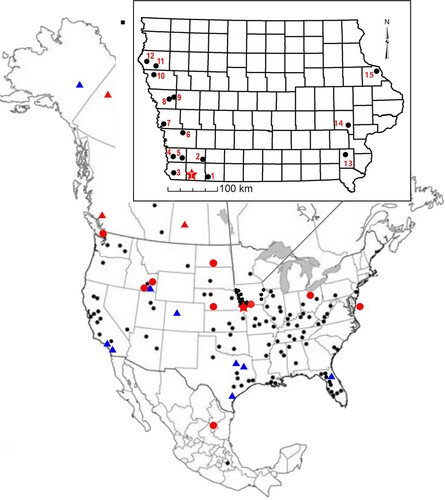
FIGURE 2. Element recovery schematic for the adult Tarkio Valley Megalonyx. Illustration by Meghan Mahoney, after Hay (Citation1914:fig. 1).
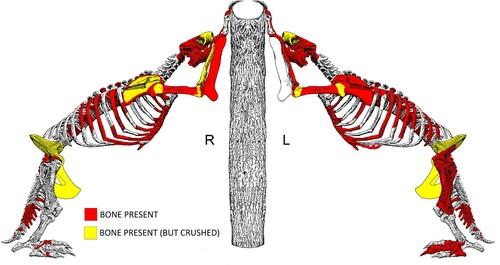
FIGURE 3. Right scapula relative sizes for the Tarkio Valley infant, sub-adult and adult. Scale is 10 cm.
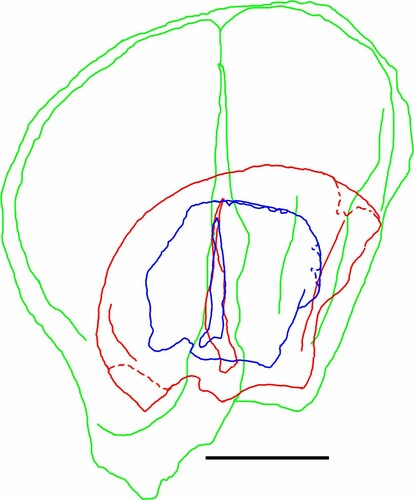
FIGURE 4. Bone distribution map for the Tarkio Valley Megalonyx locality. Elements without icons: Adult: A, atlas; CL, clavicle; F, femur; H, humerus; M, mandible; P, palate (half); PE, pelvis; R, radius; S, sternebra; SK, skull; SR, sternal rib; T, tibia; U, ulna. Juvenile: cl, clavicle; h, humerus; pe, pelvis. Other: r, rodent humerus; t, turtle (pond); ts, turtle (snapping). MM refers to both the excavation block and the online excavation journal Megalonyx Matters (Supplemental Data, Appendix S1). Missing MM numbers on the map relate to journal entries for heavy equipment days or planning session notes. Elements are sided on the paleontological repository inventory (Supplemental Data, Table S1).
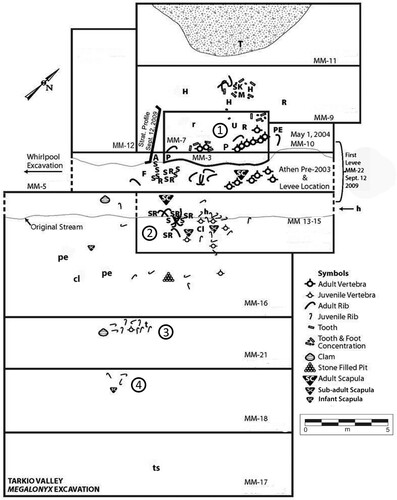
FIGURE 5. Generalized stratigraphy of cores drilled on either side of West Tarkio Creek, Tarkio Valley Megalonyx locality. Core SL-1 was drilled on the eastern loess-mantled terrace and did not penetrate to the level of the sloth-associated deposits. Core SL-2B was drilled on the West Tarkio floodplain and penetrated deposits likely correlative with the sloth-bearing alluvium in the creek bed excavation. Dashed line connecting stratigraphy in the two cores is inferred correlation of buried soil horizon. Radiocarbon and OSL ages are discussed in the text.

FIGURE 6. Grain-size, total organic carbon and carbon isotope profiles for the lower 6 meters of core SL-1 and SL-2B. A, core SL-1 (Southeast Bank); B, core SL-2B (Northwest Bank). Lower zone of core SL-2B inferred to correlate with sloth-bearing deposits in the creek bed is highlighted in red. The buried soil (2AC1b, 2AC2b) located at 9 meters depth is inferred to correlate with the buried soil (3AC1b, 3AC2b) between 6- and 7-meters depth in core SL-2b.
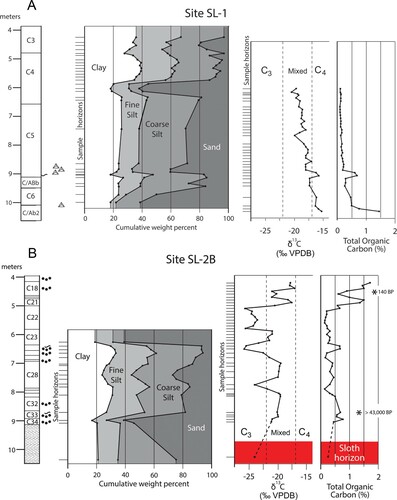
FIGURE 7. A, intrasite profile showing relationship between Sub-Units 2 and 3 (SU2 and SU3). (Scale bars are 1 m (horizontal) and 0.5 m (vertical) long. B, detail of discontinuous, reddish-brown sand laminations in lower part of profile (scale bar in 1 cm increments). C, detail of profile in A, showing redoximorphic bands that trace trough-cross-bedding in SU2 (alternating red and black portions of scale are 10 cm long).
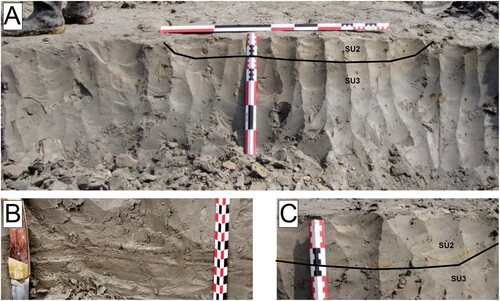
TABLE 1. Tarkio Megalonyx Skeleton Inventory and preservation percentage for the adult and sub-adult skeletons. The infant is only known from the left and right scapulae. Does not include ear ossicles (6), hyoids (7), manus sesamoids (16), lunale and cyamelle sesamoids (4), pes sesamoids (12). The numbers in parentheses represent the number of identified elements (NISP). Some infant elements may be present.
FIGURE 8. Composite sub-adult trunk assembly suggests that most of the ribs belonged to the subadult. The scale bar for the rib cage is 20 cm. The infant scapula is to the upper right, the sub-adult to the lower left. The enlargement of the remodeled puncture wound in rib SUI 102849L documents past trauma. The punctured rib is noted by a bracket. The scale bar on the latter is 10 mm.

FIGURE 9. Diseased and fused caudal vertebrae (SUI 101037CN) of the Tarkio adult, proximal to the top. A, dorsal; B, ventral; C, computerized tomography (CT) dorsal; D, CT ventral.
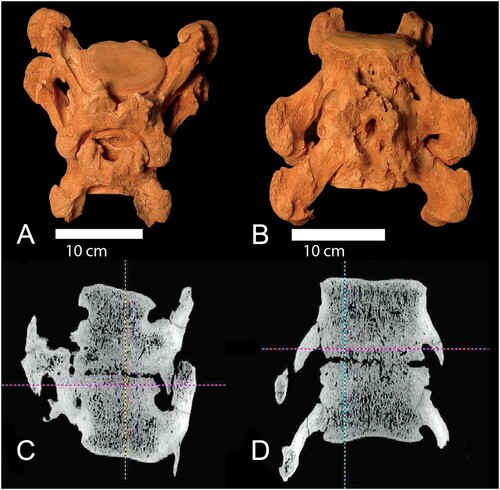
FIGURE 10. Rare earth element patterns exhibited by medial and lateral views of the Megalonyx rib (SUI 101037CC), normalized to Post-Archean Australian Shale (REEN). Sample locations and assigned weathering stages (Behrensmeyer, Citation1978) are depicted in the insets and show samples A–G for the medial side (n = 8) and A–E for the lateral side (n = 6). Segment B was sampled twice on each side and rib segment A is proximal. Solid lines indicate minimally weathered rib segments and dotted lines indicate more weathered segments.
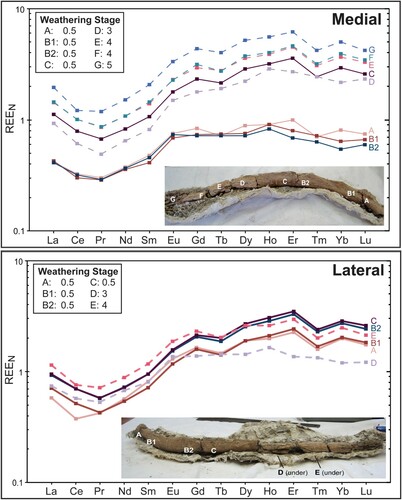
FIGURE 11. Stable isotope evaluation, transverse cross section, Tarkio Valley adult Megalonyx molariform (SUI-101037X). A, the four distinct dentine layers are numbered to avoid ambiguity in nomenclature; B, growth increments longitudinal image; C, sampling square locations 1–8 beginning at the occlusal end of the tooth; D, carbonate δ13C (‰, VPDB) for all samples by layer number; E, Vickers hardness index for each dentine layer using both 50 g and 100 g of force.
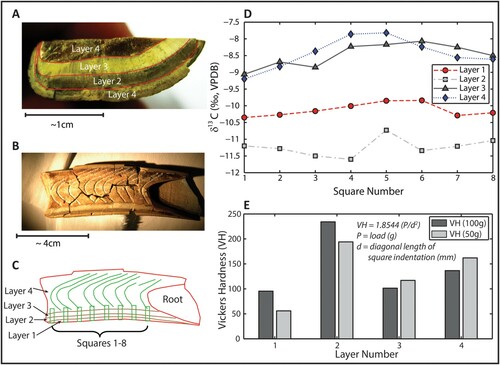
TABLE 2. Life history parameters for Megalonyx jeffersonii based on formulae from Blueweiss et al. (Citation1978) using the estimated weight of 1286 kg for the adult Tarkio Valley specimen. Abbreviations: W = weight in grams, y = days.
FIGURE 12. Bivariate plots comparing the adult Megalonyx jeffersonii from Tarkio Valley (open diamond) with other specimens of the species from Iowa (open square) and outside of Iowa (solid squares). A, upper caniniform; B, radius; C, astragalus; D, femur. Element measurements are tabulated in Supplemental Data, Table S6.
